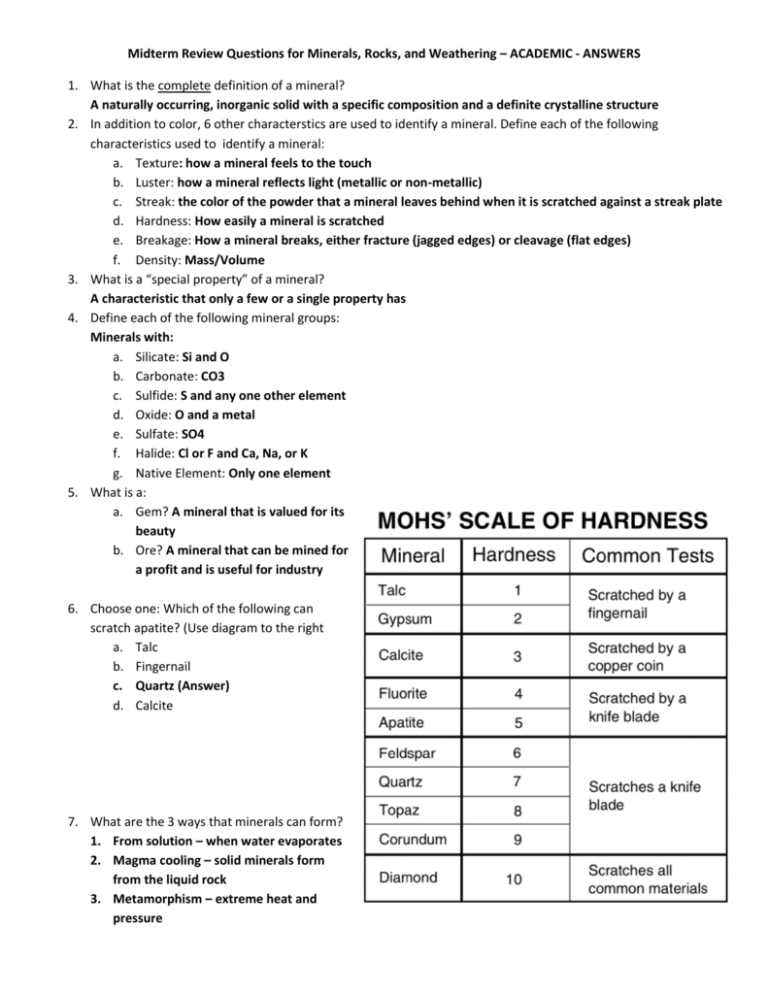Midterm Review Questions for Minerals, Rocks, and Weathering
advertisement

Midterm Review Questions for Minerals, Rocks, and Weathering – ACADEMIC - ANSWERS 1. What is the complete definition of a mineral? A naturally occurring, inorganic solid with a specific composition and a definite crystalline structure 2. In addition to color, 6 other characterstics are used to identify a mineral. Define each of the following characteristics used to identify a mineral: a. Texture: how a mineral feels to the touch b. Luster: how a mineral reflects light (metallic or non-metallic) c. Streak: the color of the powder that a mineral leaves behind when it is scratched against a streak plate d. Hardness: How easily a mineral is scratched e. Breakage: How a mineral breaks, either fracture (jagged edges) or cleavage (flat edges) f. Density: Mass/Volume 3. What is a “special property” of a mineral? A characteristic that only a few or a single property has 4. Define each of the following mineral groups: Minerals with: a. Silicate: Si and O b. Carbonate: CO3 c. Sulfide: S and any one other element d. Oxide: O and a metal e. Sulfate: SO4 f. Halide: Cl or F and Ca, Na, or K g. Native Element: Only one element 5. What is a: a. Gem? A mineral that is valued for its beauty b. Ore? A mineral that can be mined for a profit and is useful for industry 6. Choose one: Which of the following can scratch apatite? (Use diagram to the right a. Talc b. Fingernail c. Quartz (Answer) d. Calcite 7. What are the 3 ways that minerals can form? 1. From solution – when water evaporates 2. Magma cooling – solid minerals form from the liquid rock 3. Metamorphism – extreme heat and pressure 8. What is a crystal system? Why do minerals belong to certain mineral systems? A crystal’s geometric shape. Minerals have a certain shape, or mineral system, because of the arrangement of their atoms 9. Compare and contrast magma and lava. Both are molten rock, magma is under the surface, lava is on the surface 10. What are the 3 types of magma listed from the most to the least silica? Rhyolitc, Andesitic, Basaltic 11. How does an igneous rock form? Cooling of molten rock 12. List the following 4 igneous rocks from most to least silica: intermediate, felsic, mafic, ultramafic Felsic, Intermediate, Mafic, Ultramafic 13. As the amount of silica increases, what happens to the color of an igneous rock? It becomes lighter 14. How do intrusive and extrusive rocks look different? Intrusive have large, visible crystals while extrusive have small, microscopic crystals or no crystals (glassy rocks) 15. How does the speed that magma cools affect the size of the crystals in the rock? Slower it cools, larger the crystal. Too fast and no crystals form (glassy) 16. What are plutons? Igneous intrusions – masses of intrusive igneous rock that form when it cools inside the earth 17. Are plutons made of intrusive or extrusive rock? intrusive 18. Define a batholiths. The largest type of pluton 19. How do metamorphic rocks form? From extreme heat/pressure without melting 20. What is a metamorphic rock with a banded texture called? Foilated 21. The rock that undergoes metamorphism to turn into the metamorphic rock is called: Parent Rock 22. What are the 3 types of local metamorphism? Define each. Hydrothermal – contact with hot water Contact – contact with magma/lava Deformational – friction at breaks in rock 23. What is regional metamorphism? Metamorphism on a large (state size) scale 24. What are the 3 types of sedimentary rocks? What is each made from? Chemical – made from minerals that form from evaporation Clastic – made from pieces of other rock cemented together Organic – made from previously living things (shells, plant materials) cemented together 25. How do clastic and organic sedimentary rocks form? Pieces of material cemented together by heat or pressure 26. How do chemical sedimentary rocks form? Evaporation Use diagram above to answer questions 27 and 28 27. What is a intrusive, felsic rock called? Granite 28. List all of the extrusive igneous rocks. Basalt, Scoria, Obsidian 29. As a pebble is moved along in a river, what happens to its shape? Becomes Rounder 30. Choose one: The oldest layer of sedimentary rocks is located near the: a. Middle b. Top c. Bottom (Answer) 31. Which type of rock is most likely to have fossils? Choose one: Igneous, Sedimentary, or Metamorphic) Sedimentary 32. A layer of extrusive igneous rock means what happened in the past to create it? A volcanic eruption 33. A large area of metamorphic rock means what happened to that area in the past? Extreme heat or pressure 34. A layer of rock salt means what was in that place in the past? An ocean was there, it evaporated 35. What is the difference between weathering and erosion? Weathering is break down of rock and erosion is the movement 36. What is mechanical weathering? List 2 examples. Break down of rock into smaller pieces without changing chemically Ex: Frost wedging, abrasion, exfoliation, plant roots 37. What is chemical weathering? List 2 examples. Dissolving of rock and removing it chemically Ex: hydrolysis, oxidation, secreted plant acids








